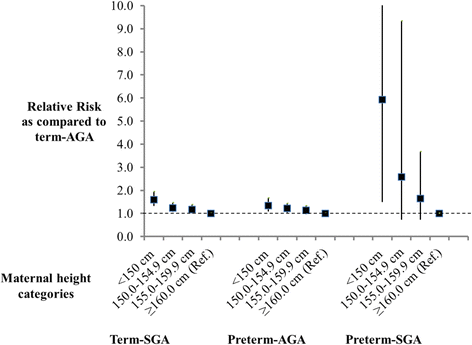Risk factors for small-for-gestational-age and preterm births among 19,269 Tanzanian newborns
- PMID: 27183837
- PMCID: PMC4869183
- DOI: 10.1186/s12884-016-0900-5
Risk factors for small-for-gestational-age and preterm births among 19,269 Tanzanian newborns
Abstract
Background: Few studies have differentiated risk factors for term-small for gestational age (SGA), preterm-appropriate for gestational age (AGA), and preterm-SGA, despite evidence of varying risk of child mortality and poor developmental outcomes.
Methods: We analyzed birth outcome data from singleton infants, who were enrolled in a large randomized, double-blind, placebo-controlled trial of neonatal vitamin A supplementation conducted in Tanzania. SGA was defined as birth weight <10th percentile for gestation age and sex using INTERGROWTH standards and preterm birth as delivery at <37 complete weeks of gestation. Risk factors for term-SGA, preterm-AGA, and preterm-SGA were examined independently using log-binomial regression.
Results: Among 19,269 singleton Tanzanian newborns included in this analysis, 68.3 % were term-AGA, 15.8 % term-SGA, 15.5 % preterm-AGA, and 0.3 % preterm-SGA. In multivariate analyses, significant risk factors for term-SGA included maternal age <20 years, starting antenatal care (ANC) in the 3(rd) trimester, short maternal stature, being firstborn, and male sex (all p < 0.05). Independent risk factors for preterm-AGA were maternal age <25 years, short maternal stature, firstborns, and decreased wealth (all p < 0.05). In addition, receiving ANC services in the 1(st) trimester significantly reduced the risk of preterm-AGA (p = 0.01). Significant risk factors for preterm-SGA included maternal age >30 years, being firstborn, and short maternal stature which appeared to carry a particularly strong risk (all p < 0.05).
Conclusion: Over 30 % of newborns in this large urban and rural cohort of Tanzanian newborns were born preterm and/or SGA. Interventions to promote early attendance to ANC services, reduce unintended young pregnancies, increased maternal height, and reduce poverty may significantly decrease the burden of SGA and preterm birth in sub-Saharan Africa.
Trial registration: Australian New Zealand Clinical Trials Registry (ANZCTR) - ACTRN12610000636055 , registered on 3(rd) August 2010.
Keywords: Birth weight; Preterm-AGA; Preterm-SGA; Risk factors; Tanzania; Term-SGA.
Figures
Similar articles
-
Short Maternal Stature Increases Risk of Small-for-Gestational-Age and Preterm Births in Low- and Middle-Income Countries: Individual Participant Data Meta-Analysis and Population Attributable Fraction.J Nutr. 2015 Nov;145(11):2542-50. doi: 10.3945/jn.115.216374. Epub 2015 Sep 30. J Nutr. 2015. PMID: 26423738 Free PMC article.
-
Maternal short stature and under-weight status are independent risk factors for preterm birth and small for gestational age in rural Bangladesh.Eur J Clin Nutr. 2019 May;73(5):733-742. doi: 10.1038/s41430-018-0237-4. Epub 2018 Jun 22. Eur J Clin Nutr. 2019. PMID: 29934512 Free PMC article.
-
Risk factors and neonatal/infant mortality risk of small-for-gestational-age and preterm birth in rural Nepal.J Matern Fetal Neonatal Med. 2015 Jun;28(9):1019-25. doi: 10.3109/14767058.2014.941799. Epub 2014 Jul 28. J Matern Fetal Neonatal Med. 2015. PMID: 25000447 Clinical Trial.
-
New Option in the Lives Saved Tool (LiST) Allows for the Conversion of Prevalence of Small-for-Gestational-Age and Preterm Births to Prevalence of Low Birth Weight.J Nutr. 2017 Nov;147(11):2141S-2146S. doi: 10.3945/jn.117.247767. Epub 2017 Sep 13. J Nutr. 2017. PMID: 28904115 Review.
-
The associations of birth intervals with small-for-gestational-age, preterm, and neonatal and infant mortality: a meta-analysis.BMC Public Health. 2013;13 Suppl 3(Suppl 3):S3. doi: 10.1186/1471-2458-13-S3-S3. Epub 2013 Sep 17. BMC Public Health. 2013. PMID: 24564484 Free PMC article. Review.
Cited by
-
The Effect of Maternal Multiple Micronutrient Supplementation on Female Early Infant Mortality Is Fully Mediated by Increased Gestation Duration and Intrauterine Growth.J Nutr. 2020 Feb 1;150(2):356-363. doi: 10.1093/jn/nxz246. J Nutr. 2020. PMID: 31605616 Free PMC article.
-
Do social factors and country of origin contribute towards explaining a "Latina paradox" among immigrant women giving birth in Germany?BMC Public Health. 2019 Feb 12;19(1):181. doi: 10.1186/s12889-019-6523-9. BMC Public Health. 2019. PMID: 30755186 Free PMC article.
-
Revisiting the Table 2 fallacy: A motivating example examining preeclampsia and preterm birth.Paediatr Perinat Epidemiol. 2018 Jul;32(4):390-397. doi: 10.1111/ppe.12474. Epub 2018 May 21. Paediatr Perinat Epidemiol. 2018. PMID: 29782045 Free PMC article.
-
Advanced maternal age impacts physiologic adaptations to pregnancy in vervet monkeys.Geroscience. 2020 Dec;42(6):1649-1661. doi: 10.1007/s11357-020-00219-8. Epub 2020 Jun 25. Geroscience. 2020. PMID: 32588342 Free PMC article.
-
Maternal and dietary behavior-related factors associated with preterm birth in Southeastern Terai, Nepal: A cross sectional study.Front Public Health. 2022 Sep 15;10:946657. doi: 10.3389/fpubh.2022.946657. eCollection 2022. Front Public Health. 2022. PMID: 36187702 Free PMC article.
References
-
- UNICEF and WHO. Low Birth Weight: Country, Regional and Global Estimates. New York. 2004. http://www.unicef.org/publications/index_24840.html. Accessed 15 Jun 2015.
-
- Blencowe H, Cousens S, Oestergaard MZ, Chou D, Moller A-B, Narwal R, et al. National, regional, and worldwide estimates of preterm birth rates in the year 2010 with time trends since 1990 for selected countries: a systematic analysis and implications. Lancet. 2012;379:2162–72. doi: 10.1016/S0140-6736(12)60820-4. - DOI - PubMed
-
- Berkowitz GS, Papiernik E. Epidemiology of preterm birth. Epidemiol Rev. 1993;15:414–43. - PubMed
-
- Lee ACC, Katz J, Blencowe H, Cousens S, Kozuki N, Vogel JP, et al. National and regional estimates of term and preterm babies born small for gestational age in 138 low-income and middle-income countries in 2010. Lancet Glob Heal. 2013;1:e26–36. doi: 10.1016/S2214-109X(13)70006-8. - DOI - PMC - PubMed
Publication types
MeSH terms
Substances
Associated data
LinkOut - more resources
Full Text Sources
Other Literature Sources
Medical
Miscellaneous


